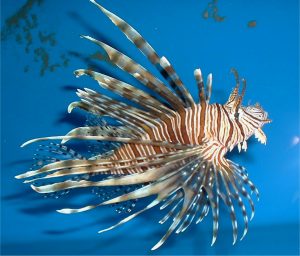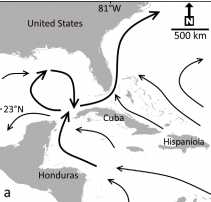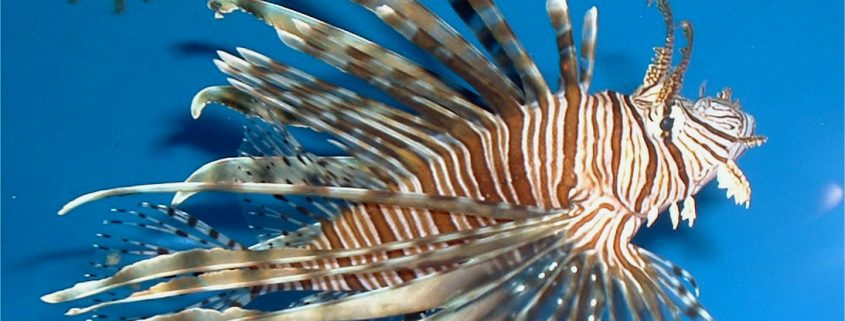Observing Invasive Lionfish Larval Dispersal Through Ocean Currents May Help to Reduce Population Size
By Dana Tricarico, RJD Intern
The waters of the Caribbean, Western Atlantic and Gulf of Mexico have become a hub for the invasive species called Pterois volitans and Pterois miles, more commonly known as species of Indo-Pacific lionfish. This predatory species is now an increased problem, creating negative ecological consequences to its non-native regions since 1992, when Hurricane Andrew knocked several lionfish into the waters of South Florida. According to National Geographic, they are now one of the most destructive invasive species in the Western Hemisphere and have become the first truly invasive marine fishes in the Atlantic (Albins and Mark, 2013). Since then, researchers like Dr. Matthew Johnston and Dr. Sam Purkis have been seeking ways to help manage the overabundance of this species. One major reason for the effort from scientists is due to the fact that lionfish have the potential to outcompete and prey on a large array of different types of species from all areas they inhabit. This implies that the more these species reproduce, the greater the decline of other fish recruitment, i.e. the amount of fish that survive to be added to a population (Albins and Mark, 2013).

The Indo-Pacific Lionfish is an invasive species to the Gulf of Mexico, Caribbean and East Coast of the United States. (Source: http://www.noaanews.noaa.gov/stories2006/images/lionfish-morris.jpg)
At this point, it is no secret that lionfish are taking over. It is also apparent to many that consistent removal efforts are required as frequently as possible in order to try and manage the populations. This becomes more of a priority because, in addition to being ravenous predators, their reproduction rate is extremely high. In fact, one female lionfish can produce over two million eggs per year (Spencer, 2015).
Such a high frequency of spawning, with no indication as to when the next spawning period will be, leads to major complications in how to move forward in the eradication efforts. However, new research shows that there may be a way to combat issues associated with this. At this point, lionfish control is usually administered through “culls” either through local lionfish derbies, or by recreational spear or net fishing. Unfortunately, reducing the overall lionfish numbers in the invaded areas is usually unsuccessful with only these localized and sporadic derby events, which typically focus on adult fish in shallow water. The motivation of the study was to determine if local lionfish control such as those previously listed, in addition to increased removal efforts at many other locations with high larval connectivity, can help decrease lionfish biomass in downstream currents. In other words, this study wanted to look at areas where lionfish larval dispersal from one population to another was the strongest, and whether or not that could help in reducing lionfish populations (Johnston and Purkis, 2015a).
The Carolinas were chosen as the focus area for this study because dense lionfish populations had been found there from lionfish recruits, which traveled from locations like Cuba, the east coast of Florida, the Florida Keys, and other areas in which the Gulf Stream current passes through. Ten spawning areas were looked at in order to note where the lionfish from these locations eventually settled. A biophysical computer model was used in this study in order to look at the sites. This model took into consideration ocean climate data, ocean currents as well as life-history traits of lionfish to dictate the eventual settlement location of the lionfish. In addition to this model, previous research by Johnston and Purkis (2015a) showed that not only do the currents affect the dispersal of lionfish downstream of the Gulf Stream, but also hurricanes and other tropical storms can accelerate the spread of the lionfish as well due to a change in the flow of the water after these natural disasters. This is likely why the spread of lionfish was so quick after Hurricane Andrew hit the South Florida area (Johnston and Purkis, 2015b).

The circulation pattern of ocean currents in the Caribbean, Gulf of Mexico and western Atlantic indicated by arrows.
Through the computer models, it was apparent how complex the linkages were between the study areas, and it was clear that there was a south-to-north flow of larvae, ending in the Carolinas. Johnston and Purkis estimated that regular removal of at least 20% of the population per month in heavily populated areas of lionfish, in addition to 20% of culling in regions upstream of large ocean currents, would be needed to effectively reduce lionfish numbers. These numbers also need to include all ages and sizes of fish, unlike the pattern typically seen in local lionfish derbies. The Caribbean, United States, Mexico, Central, and South America should all be targeted regions. The simulations also showed that Cuba exported lionfish to eight of the ten studied areas, so a significant amount of culling in both northern and southern Cuba would help in the great decline of lionfish (Johnston and Purkis, 2015a).
This study is significant to those trying to stop the ongoing invasion because it demonstrates the extreme need to introduce a more coordinated and prolonged international cooperation between nations linked via ocean currents and affected by increased lionfish populations. As Johnston states, “We’re all connected by water flow. That means one area that has uncontrolled lionfish populations can dramatically increased lionfish numbers in nations downstream (Nova Southeastern University, 2015).”
References:
Albins Mark A., and Mark A. Hixon. “Invasive Indo-Pacific lionfish Pterois volitans reduce recruitment of Atlantic coral-reef fishes.” Marine Ecology Progressive Series 367:233–238 (2013).
Johnston, Matthew W., and Sam J. Purkis. “A Coordinated and Sustained International Strategy Is Required to Turn the Tide on the Atlantic Lionfish Invasion.” Marine Ecology Progress Series Mar. Ecol. Prog. Seri. 533 (2015a): 219-35.
Johnston, Matthew W., and Sam J. Purkis. “Hurricanes Accelerated the Florida-Bahamas Lionfish Invasion.” Glob Change Biol Global Change Biology 21.6 (2015b): 2249-260.
Nova Southeastern University. “More strategic culling needed to reduce lionfish invasion, researchers find.” ScienceNews. ScienceDaily, 11 August 2015.
Spencer, Erin. “Fighting Back Lionfish for Invasive Species Awareness Week.” Voices Explorer Journal. National Geographic, 24 Feb. 2015. Web. 22 Mar. 2015.




Leave a Reply
Want to join the discussion?Feel free to contribute!